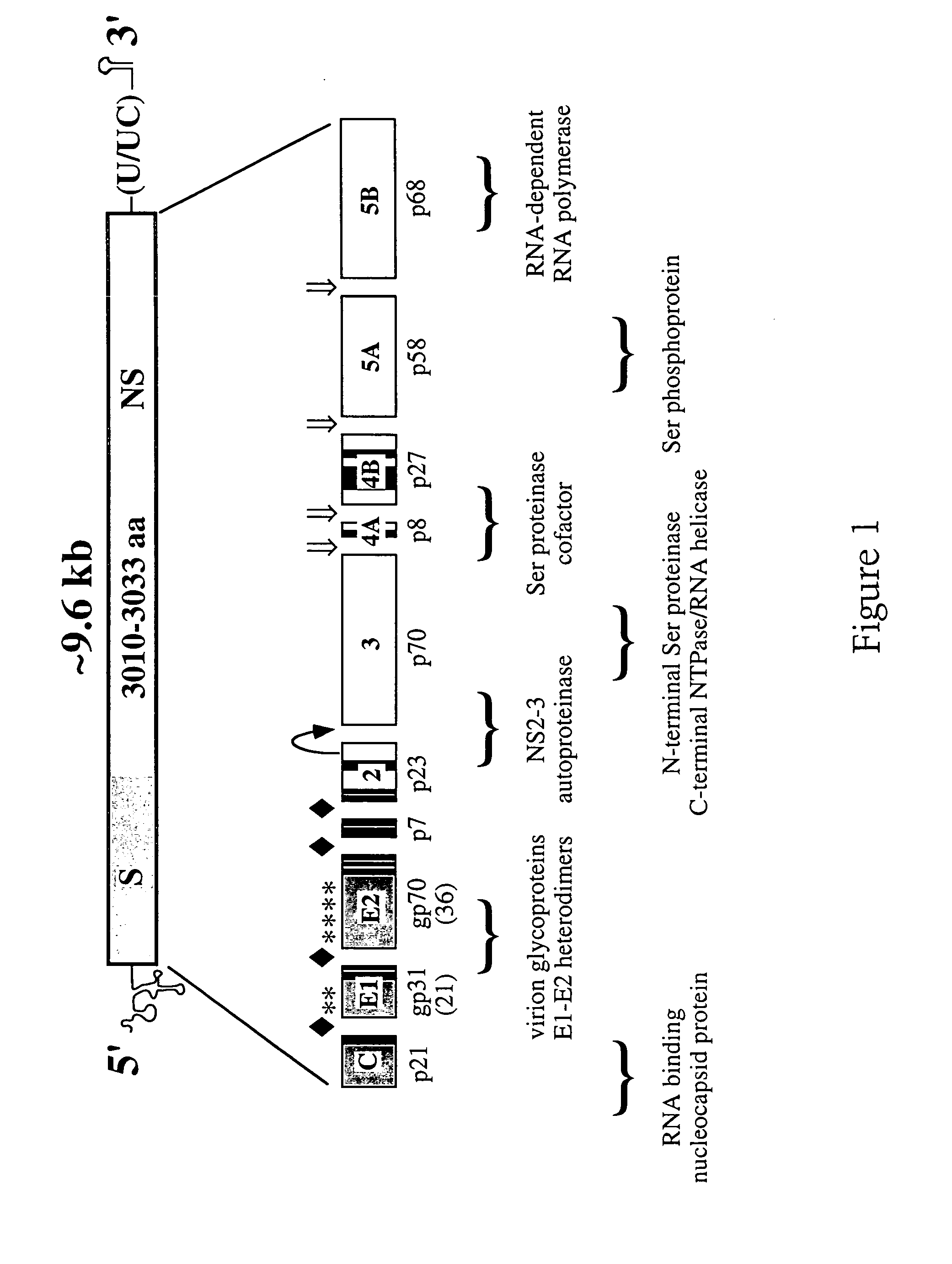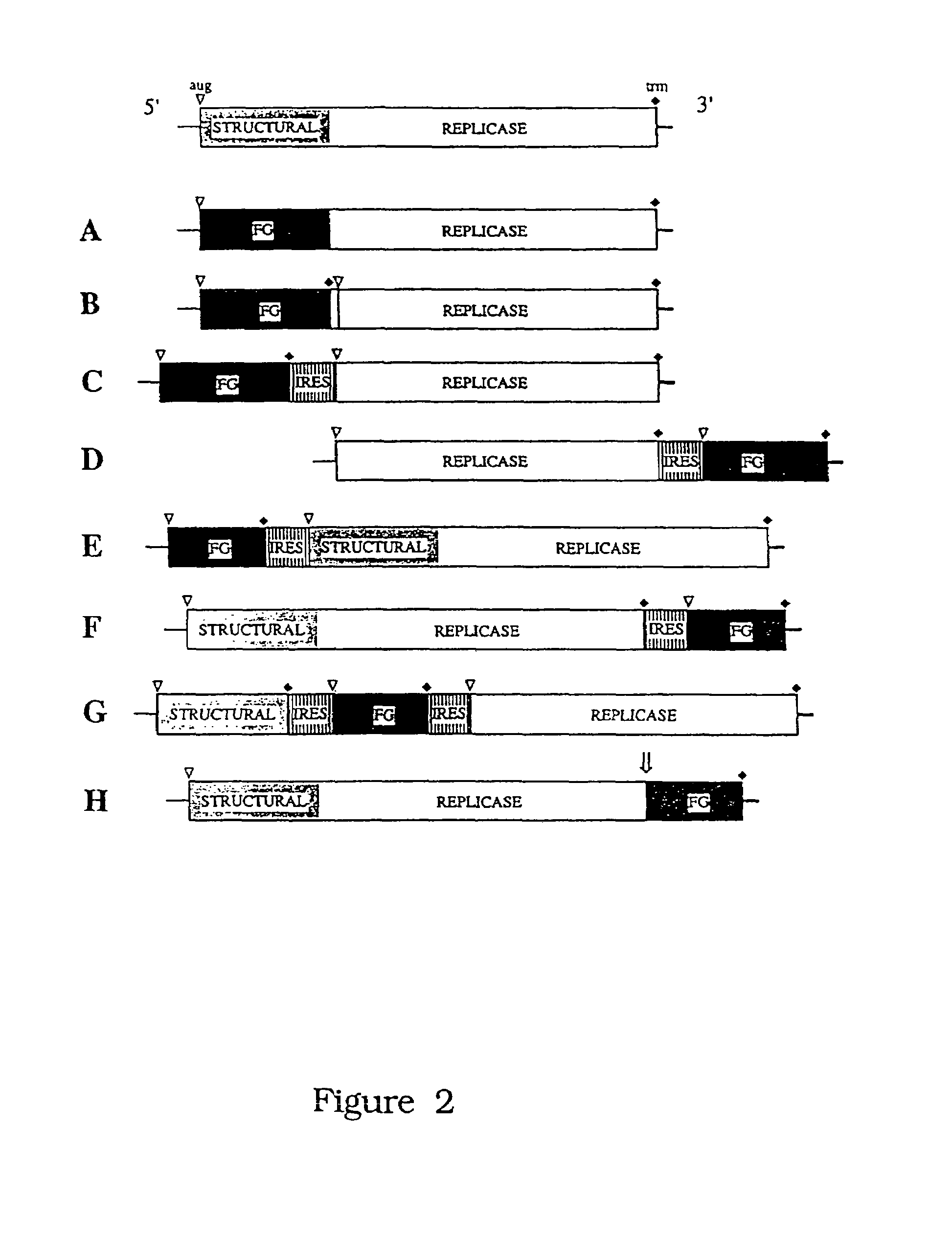Functional DNA clone for hepatitis C virus (HCV) and uses thereof
a dna clone and hepatitis c virus technology, applied in the field of determining the functional rna sequence of the hcv virus, can solve the problem of not being certain that the starting material for further analysis of the hcv was useful
- Summary
- Abstract
- Description
- Claims
- Application Information
AI Technical Summary
Benefits of technology
Problems solved by technology
Method used
Image
Examples
example 1
Analysis of HCV-H Genome Structure and Expression
[0202]Rationale for the HCV-H strain, cDNA cloning, sequence analysis, and assembly of nearly full-length cDNA clones. HCV-H strain was chosen for the initial studies since this isolate has been extensively characterized in chimpanzees by Purcell and colleagues [see Shimizu et al., (1990) supra] and more recently in vitro by Shimizu and coworkers [Hijikata et al., (1993) supra; Shimizu et al., J. Virol. 68: 1494–1500 (1994); Shimizu et al., Proc. Natl. Acad. Sci USA 89: 5477–5481 (1992); Shimizu et al., Proc. Natl. Acad. Sci. USA 90, 6037–6041 (1993)]. HCV-H is a genotype 1a human isolate from an American with posttransfusion NANB hepatitis [Feinstone et al., J. Infect. Dis. 144: 588–598 (1981)].
[0203]Initial cDNA cloning and sequence analysis of HCV-H. The original HCV-H77 isolate was passaged twice in chimpanzees, both of whom developed elevated serum ALT levels and acute hepatitis. Liver tissue from the second chimpanzee passage wa...
example 2
First Attempt at Recovery of Functional HCV from cDNA
[0206]Plasmid constructions. The preferred strategy for production of high specific infectivity potentially infectious HCV RNA transcripts [see Ahlquist et al., Proc. Natl. Acad. Sci. USA 81: 7066–7070 (1984); Rice et al., New Biol. 1: 285–296 (1989); Rice et al., (1987) supra and refs. therein], involved cloning of candidate full-length HCV cDNAs immediately downstream from a bacteriophage promoter (SP6 or T7) with a unique restriction site following the HCV 3′ terminus for production of run off RNA transcripts (FIG. 4). The T7 or SP6 transcription systems were chosen for production of potentially infectious RNAs for several reasons. First, numerous examples exist for other RNA viruses where either T7 or SP6 have been successfully used to transcribe high yields of relatively high specific infectivity capped or uncapped RNA transcripts [Boyer and Haenni, J. Gen. Virol. 198: 415–426 (1994)]. In addition, the T7 system is particular...
example 3
Second Attempt to Recover HCV from cDNA
[0211]Possible reasons for failure of Attempt I. Several possible explanations, alone or in combination, could account for previous unsuccessful attempts to recover infectious HCV RNA from prototype HCV-H clones (pTET / HCVFLCMR). These include missing or incorrect terminal sequences, internal errors deleterious or lethal for HCV replication, or inadequate methods for assaying infectivity and replication. To address the first concern, the HCV-H 5′ and 3′ terminal sequences were rigorously determined. To increase the chances of recovering a full-length clone free of deleterious errors, high fidelity RT / PCR and assembly PCR was used to construct a new library of full-length HCV-H clones which included the new terminal sequences. Multiple clones from the library were tested for infectivity in the chimpanzee model.
[0212]Rationale for rigorously determining the HCV-H termini. As mentioned above, the 5′ and 3′ terminal sequences of HCV-H were unknown; ...
PUM
| Property | Measurement | Unit |
|---|---|---|
| size | aaaaa | aaaaa |
| density | aaaaa | aaaaa |
| pH | aaaaa | aaaaa |
Abstract
Description
Claims
Application Information
 Login to View More
Login to View More - R&D
- Intellectual Property
- Life Sciences
- Materials
- Tech Scout
- Unparalleled Data Quality
- Higher Quality Content
- 60% Fewer Hallucinations
Browse by: Latest US Patents, China's latest patents, Technical Efficacy Thesaurus, Application Domain, Technology Topic, Popular Technical Reports.
© 2025 PatSnap. All rights reserved.Legal|Privacy policy|Modern Slavery Act Transparency Statement|Sitemap|About US| Contact US: help@patsnap.com



